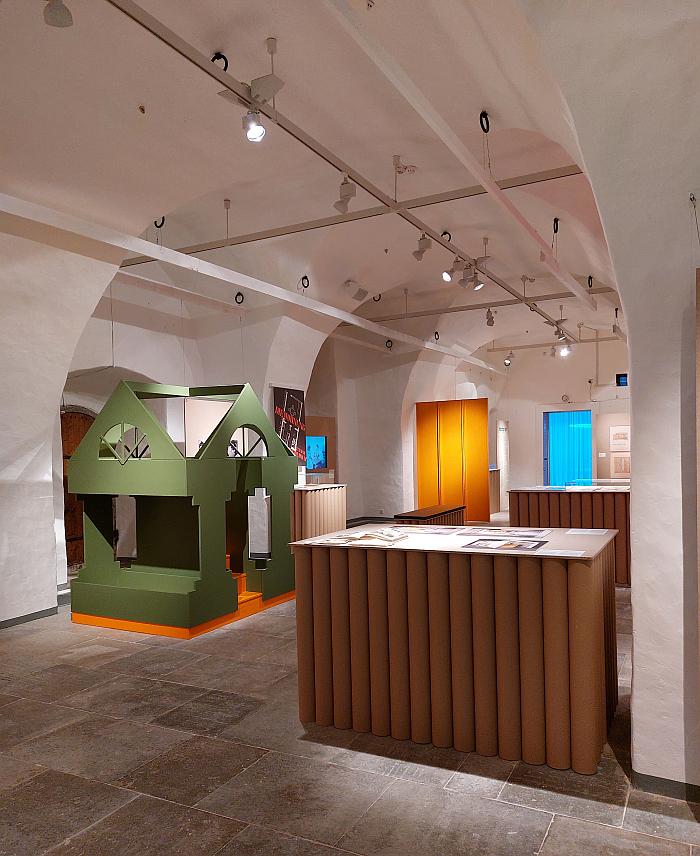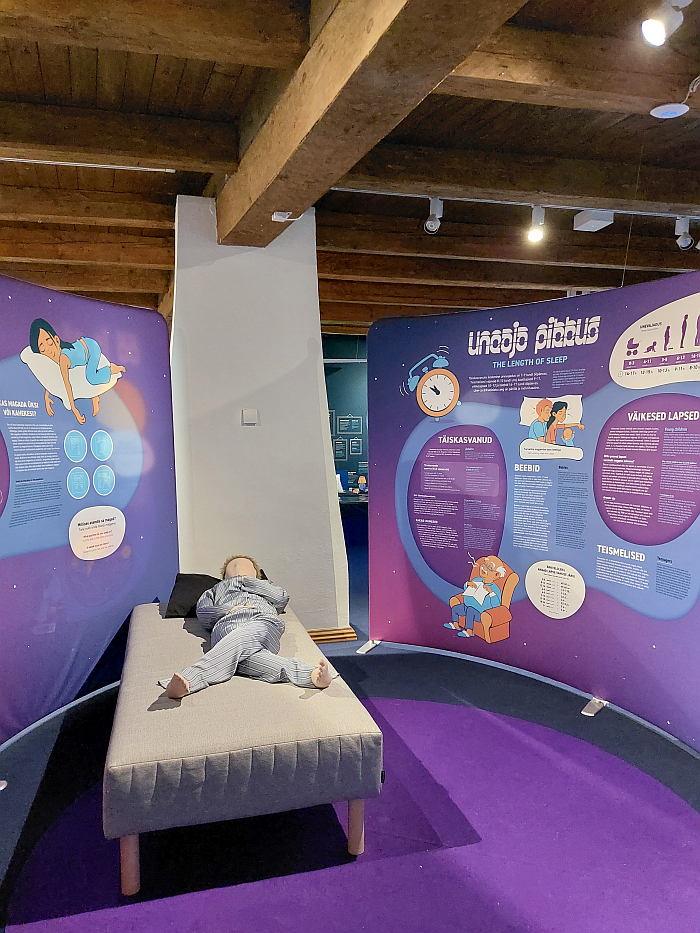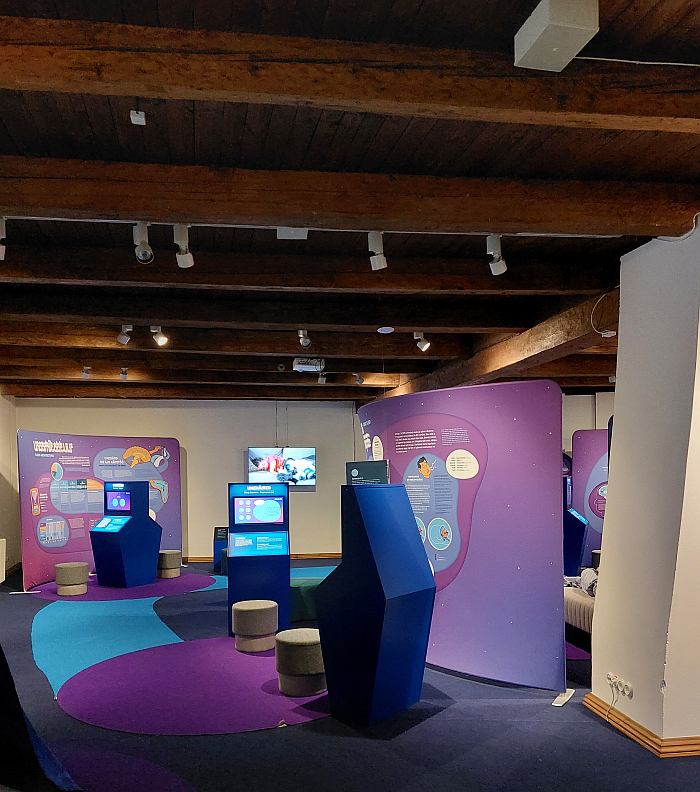Uneversum: Rhythms and Spaces at the Estonian Museum of Applied Art and Design, Tallinn
Arguably little characterises contemporary society, certainly contemporary European society, better than our relationship with sleep.
And, arguably, little charts the path of human society, again certainly European society, better than the (hi)story of our relationship with sleep.
With the exhibition Uneversum: Rhythms and Spaces the Estonian Museum of Applied Art and Design, Tallinn, explore and reflect upon sleep, spaces of sleep, rhythms of sleep, and for all on our relationships with sleep past, present and future…….
Sleep is a biological process, a physiological process, an essential process, an apparently simple process of need and necessity, of impulse and response; what could be more straightforward than sleep? However, and as with so much in human society, despite the apparent simplicity of sleep, as a component of collective and individual human existence sleep is, as we all know, if rarely admit, anything but straightforward.
As an exhibition Uneversum: Rhythms and Spaces concerns itself with sleep beyond the biological processes and physiological processes, concerns itself with sleep in all its complexity, in all its spaces, in all its rhythms, in all its wonder; an exploration undertaken in the course of four chapters, starting with Designing and Depicting Time, a chapter which, and very much as with the exhibition Time, Freedom and Control – The Legacy of Johannes Bürk at the Uhrenindustriemuseum, Villingen-Schwenningen, reflects on the reality that back in the day we rose with the sun, went to bed with the sun and in-between did what needed doing. Time as such didn’t exist. And sleep was simply what you did when it was too dark to work, something that was important, essential, and something that fitted in naturally with the rhythms of the physical universe. Then came the capitalists with their factories and mines and railways and we all started setting our alarm clocks and checking our watches. And then came universal electricity and it was light 24 hours a day. In the home and in the factory. And sleep became that which you did when you had the chance, something that was important, essential, and something that you fitted into the rhythms of the economic universe. Or put another way, sleep became a commodity like all others: and as with all commodities some had access to more, some access to less, and it could always be traded.
Developments reflected on in Uneversum by, and amongst other exhibits, a 1974 steel and plexiglass desk clock by Tõnu Riit, a clock realised in context of Riit’s considerations on time, on timepieces, on the relationships between time and timepieces, the relationships between time, timepieces and human societies and the, for Riit, necessity to find “lahenduse ajaprobleemile ning tasakaalule inimese ja keskkonna vahel” 1, ‘a solution to the time problem and the balance between humans and the environment’; or Sweepers Clock from Maarten Baas’s Real Time series, in which two lines of rubbish stand proxy for the hands of a clock as they are swept round the floor to mark the passage of time. Projects which help highlight that for all that time unquestionably is a thing, that the earth turns, seasons transition from one to the other in an unending regular flow, while all that is real, divisions of time into hours, minutes, months et al is an artificial construct. An artificial construct initially developed by our forbearers as rough, inaccurate, tools to assist in the management of the collective day, and to enable the celebration of innumerable religious festivities, but which over the centuries we have increasingly perfected, increasingly refined, increasingly ignored the inconsistencies of, increasingly embedded in our individual days, increasingly made a central component of economic activity, and are now guided, led, by, and that increasingly away from the turning of the earth and transitioning of the seasons that we were once led by. And which we once slept in tune with.
And also approached via alternative positions on and to sleep cycles, on cycles not driven by the needy demands of the economy or to comply with the social rhythm of a given urban space, but driven by reflections on what the individual human body actually needs, what is positive for the individual. Alternative systems including Richard Buckminster Fuller’s reduction in the early 1940s of his sleeping pattern to four half hour naps a day, a 2 hours a day routine that according to Bucky bequeathed him “the most vigorous and alert condition I have ever enjoyed” 2, a sleep pattern based on a succession of short naps rather than one long sleep practised by various animals, most recently described in Chinstrap penguins who manage 11 hours sleep a day via some 10,000 4 second naps3, thus a sleep pattern which tends to underscore the position that other animals have better solutions than humans, even if there is a suspicion that Bucky’s vigour and alertness were actually a manifestation of sleep deprivation; however, and paying no heed to our natural cynicism, a sleeping pattern which Bucky was forced to abandon as, invariably, it didn’t fit in with the conventional routines of the 1940s. But then neither did Bucky fit in with the 1940s. And also approached via the installation Circadian Dreams by designer/researcher Helga Schmid, a work developed in context of her Uchronia project/platform and which, and simplifying more than is prudent but which limits of space demands, proposes paths to more natural rhythms, paths to rhythms based on innate human cycles rather than the constructed, contrived, cycles we follow today, and whose principles are described in the ten point Uchronia Manifesto and visualised in an immersive light and soundscape within which visitors can lie down and attempt to disconnect from their conditioned rhythm and reconnect with their body’s innate rhythm.
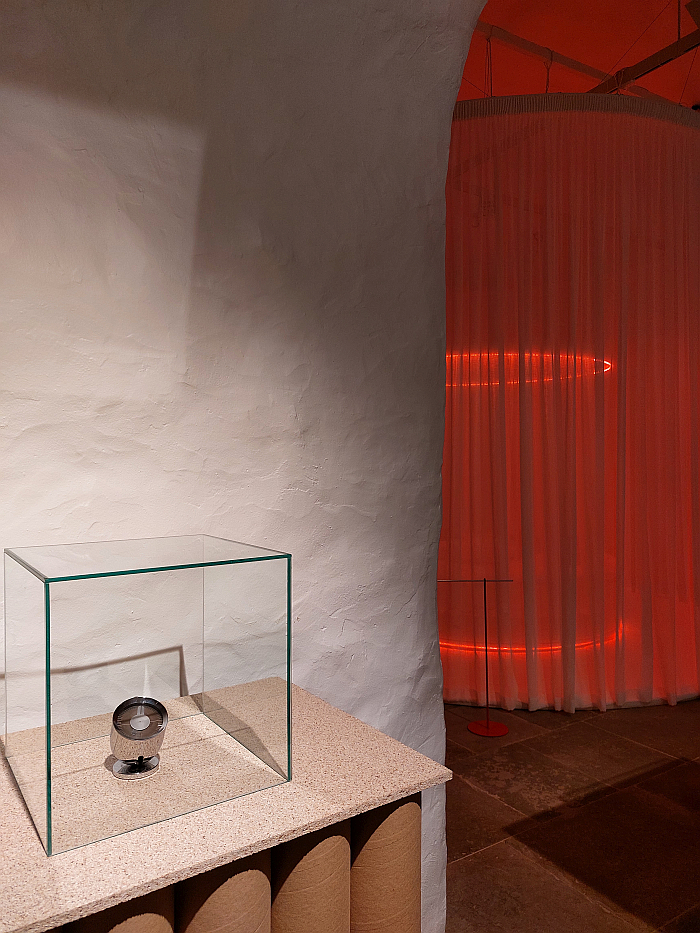
A 1974 clock by Tõnu Riit (l) and Circadian Dreams by Helga Schmid (r), as seen at Uneversum: Rhythms and Spaces, Estonian Museum of Applied Art and Design, Tallinn
And developments, in many regards, also approached in the chapter The Sleep of Machines, a chapter which, if one so will, moves the discussion from control of sleep in the industrial age to control of sleep in the post-industrial age, something joyously, deliciously, embodied by the over-dimensional ‘Power’ symbol painted on the wall of, silently dominating, the Estonian Museum of Applied Art and Design’s, ETDM’s, ground floor exhibition space. A ‘Power’ symbol, that vertical line disrupting the quiet flow of a circle which, as one learns in Uneversum, started out as a line for ‘On’ and a circle for ‘Off’, before the two became amalgamated to ‘Standby’. An apparent natural union of the two, even though that simply cannot be, rather, as we all appreciate, ‘Standby’ means just less ‘on’ than before, less ‘awake’ than before, but still ‘on’, still ‘awake’, like a cow standing motionless in a field. A state which while fine for a cow, is pretty awful for a human. And a symbol which now means ‘Power’: ‘Standby’ that intolerable state of being less ‘on’, less ‘awake’ than before has been replaced by, superseded by, extinguished by, the even more intolerable state of never being ‘off’, never being ‘asleep’, where ‘off’, ‘asleep’ isn’t an option. ‘Off’ as it is being violently, irrevocably, disrupted by ‘On’. Pure poetry. In the sterile banality of a standard International Electrotechnical Commission symbol. A symbol you will never look at in the same way again having viewed Uneversum. And whose over-dimensional silent domination of Uneversum is deliciously oppressive.
And a state of always being ‘awake’, ‘on’, that has arisen not least on account of our universal digital, networked technology and reachability, our contemporary obsession with digital technology, networking and reachability, an obsession that we carry with us wherever we go, including to bed, to that most private of spaces, that space so intimately associated with sleep.
Beds, those most private of spaces, those spaces so intimately associated with sleep, where we lie with our phones, doom scrolling social media and checking how many steps we’ve taken and buying second hand jumpers and exchanging messages with others in their beds, in their dominions of sleep. And who are invariably also checking how many steps they’ve taken. And buying a second hand jumpers by way of a reward.
Beds, those most private of spaces, those spaces so intimately associated with sleep, from where ever more of us work: in 2012 The Wall Street Journal made reference to several studies that implied, for example, that around 50% of American office workers worked from bed or that some 20% of British office workers spent between 2 and 10 hours a week working from bed.4 But that was 2012, today, not least on account of Post-Covid-Home-Office-Normality that figure is almost certainly higher. In America, the UK, Estonia, wherever.
Beds, those most private of spaces, those spaces so intimately associated with sleep, as an unambiguous symbol of changing relationships to sleep: once it was was the cycles of the sun that kept us awake, then the capitalists kept us awake with their selfish demands, now we keep ourselves awake. Voluntarily. Subconsciously. Compulsively. Unquestioningly. Unthinkingly.
And beds, as one learns in the chapter Room for Sleep, that are, certainly as we understand them today as those most private of spaces, as those spaces so intimately associated with sleep, essentially a 19th century invention, as, in many regards, is the concept of the bedroom as a distinct room; the bedroom as a room in any and every house house with its very singular role, singular practices, singular rituals, singular tools, singular associations, singu……. Oh stop it!!! Honestly!!! Not like that!!! Yous are awful!!! Honestly!!!
And a (hi)story of the bedroom… no… stop… that’s quite enough of that…. stop……. a (hi)story of the bedroom primarily approached in Uneversum in context of the architecture and design of sleep, i.e. those physical spaces and objects we have developed and which we employ to aid and abet sleep, those nests and other constructions we’ve developed by way of advancing the comfort and security of sleep. And which remind that we are but animals, nothing more, nothing less.
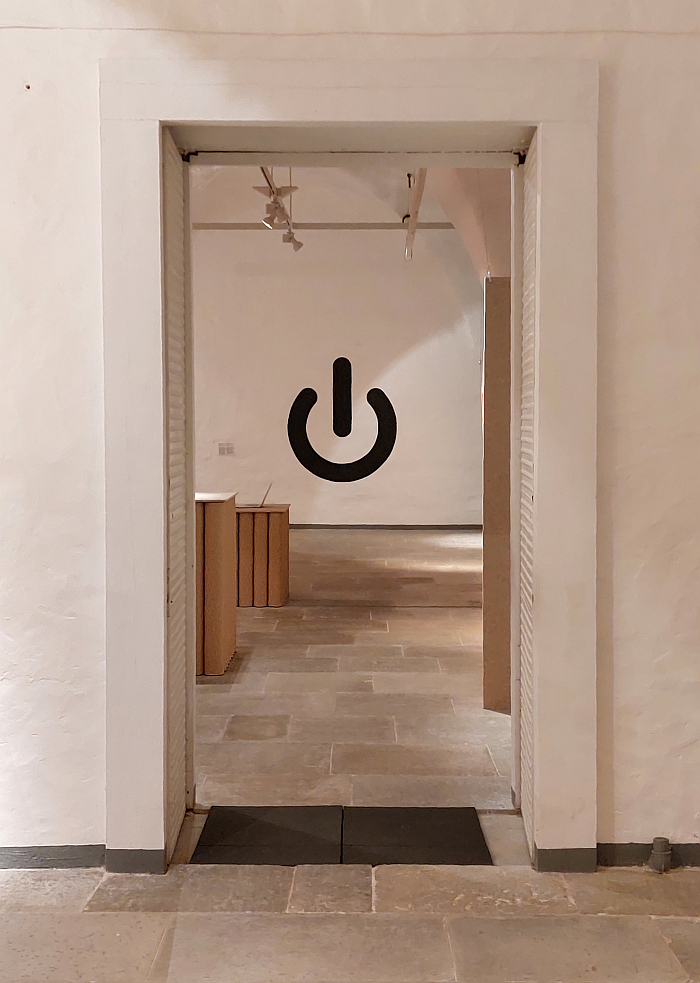
The all-dominant International Electrotechnical Commission ‘Power ‘ symbol, as seen at Uneversum: Rhythms and Spaces, Estonian Museum of Applied Art and Design, Tallinn
A chapter with very much a 20th and 21st century focus and which features, amongst many other works, a brief discussion on bedrooms in the experimental smaller apartments of the first third of the 20th century, those Functionalist Modernist attempts at making urban living affordable, healthy and egalitarian, including, for example, the bedrooms of Margarete Schütte-Lihotzky’s so-called ZWOFA houses for the Neues Frankfurt project, ZWOFA being part of the outrageous nomenclature employed by the otherwise so minimal, sober, Neue Frankfurter, and which included, as noted from Wie wohnen die Leute? at the Historisches Museum Frankfurt, MEFAGANG, EFATE, ZWOFADOLEI and ZWOFA, Zweifamilienhaus, semi-detached; and ZWOFA’s in which, as Uneversum elucidates Schütte-Lihotzky employed in-built storage by way of saving space, a space-saving solution that echoes back to her tenure with the early 20th century Siedlerbewegung in her native Vienna. Or by the apartment block realised in the early 1960s at Gonsiori 18 in the west of Tallinn by a collective of architect’s from the, then, state planning/construction institution Estonprojekt in context of attempts to improve both the construction processes and responsiveness and meaningfulness of smaller apartments in context of the realities of 1960s Estonia and 1960s Estonians, and thus also a component of that search, ongoing since the early 20th century, for solutions to urban accommodation, a reminder that to this day we’re still chasing that Functionalist Modernist vision of affordable, healthy, egalitarian urban accommodation. Or by Valentin Kuusk’s 1964 M-259 armchair-bed for Narva Mööblivabrik, an object that folds from an armchair to a bed and back to an armchair, a work designed specifically for providing a room for sleep in a small space that would, conceptually and practically, have been just as at home in 1960s Gonsiori 18 or a 1920s Frankfurt ZWOFA, or in the 19th century; in 1871 one George Wilson of Chicago was granted US patent 116,784 for, essentially, an iron framed armchair that “may be used as a reclining-chair, rocking-chair, lounge, bed and child’s crib“, and thus offered greater variability, adaptability, than Kuusk’s M-2595. And an M-259 that would be at home in the 21st century; while perhaps not as popular as the sofa-bed, the armchair-bed is still very much a thing, thereby making the M-259 another nice reminder of the helix on which we’re travelling. If a M-259 where for the life of us we can’t work out where the extra legs necessary for the bed are stored when its an armchair; they appear to be hidden in the upholstery, but where? They could be external, something stored in a cupboard that you add, but that would destroy the concept, where are the legs? Is the M-259 genius or a missed opportunity?
Or the beds developed by Helle Gans in 1978 for the Pärnu KEK’s Trall, Troll, Kindergarten and the beds developed in 1983 by Niina Eigi for the Piilupesa, Hideout, kindergarten at the Kirov Fishing Collective at Haabneeme, a little to the north of Tallinn. The latter a two storey castle construction in which four children could sleep, hide out, in single beds, a work simultaneously playfully responsive to the rejection in the 1980s of the dogmatic adherence to the quadratic demanded by the inter and post War Modernists, and playfully responsive to the needs and imaginations of children: form and function in concurrence, but not as the relationship had been defined two generations earlier. And which is joyous to observe. And tragically informative to understand that in the 1990s they were left to rot in the derelict, now demolished, Kindergarten complex. The former a space saving bunk bed concept in which a drawer beneath a bed is pulled out, lengthways, to reveal a second bed. And while without question a very nice re-imagining of the horizontally unfolding Settle Bed, there is, equally unquestionably, something very morbid in the concept of sleeping in a lengthways extruded drawer, it has something of the mortuary storeroom about it; however, that is possibly also an adult opinion, kids probably love it. As would Trollid.
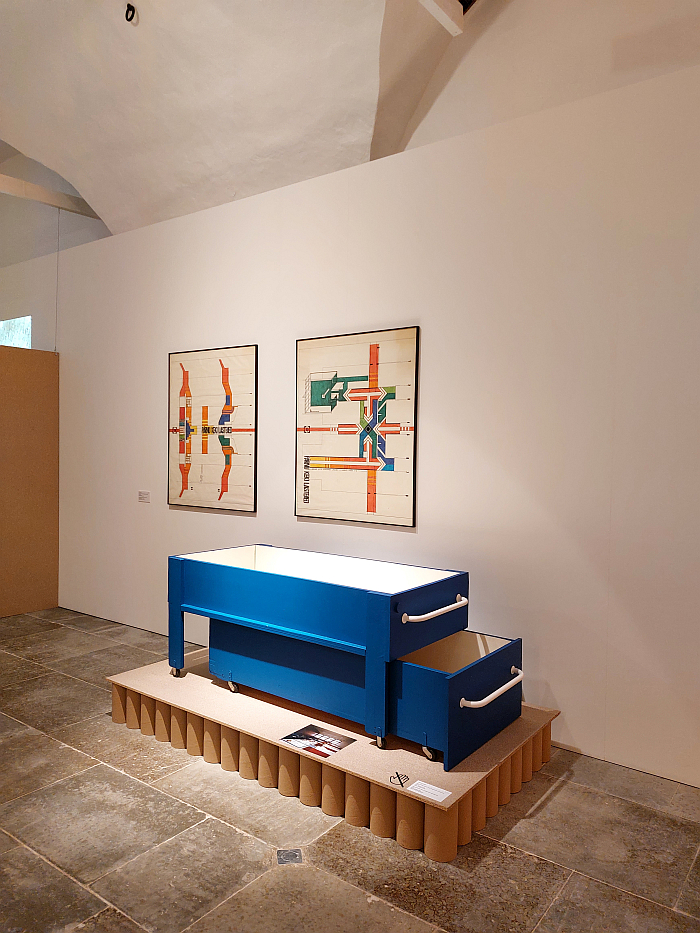
A bed by Helle Gans for the Pärnu KEK’s Trall Kindergarten, as seen at Uneversum: Rhythms and Spaces, Estonian Museum of Applied Art and Design, Tallinn
Uneversum ends with thoughts on the future of sleep. A future, conceivably, one or the other Californian is currently planning to ensure never happens; somewhere in California, one can well imagine, someone is mischievously planning to make sleep a thing of the past. Unproductive as it is.
Or is it?
What if we could use our time asleep? What if we could, for example, harness our dreams? Who hasn’t woken up in a state of extreme irritation because you know that in your dream you had the best idea in the world, ever. Solved an insurmountable problem. And now you can’t remember what it was. Can only remember it was brilliant, elegant, faultless; however, and much like Virgina Woolf’s narrator’s little fish/thoughts in A Room of One’s Own disturbed by the flailing arms of a college beadle, the act of wakening has sent that thought/fish into hiding. Lost in a flash of light, never to be seen again. What if we could capture dreams? What if we could record dreams? What if we could harness dreams? What if we could use dreams as a tool? Which, yes, is admittedly much more the sort of project the Californians are feverishly working on. And also devising ways to nefariously acquire our dreams for free as the basis for their high-yielding business model. Someone in the late 19th century is trying to abolish sleep. It’s very much old economy thinking.
And a question of the future of sleep, of the future role of sleep, of future relationships with sleep, future spaces and rhythms of sleep, explored in Uneversum through projects such as, for example, Undefined Useful Object #22 and #23 by Kärt Ojavee, the latter a low-tech barrel organ which plays re-workings of songs first imagined in dreams, and which neatly embodies that transient moment when those brilliant ideas arrive and depart as if they’d never been, or the video essay Sleep with Pointing by Tõnis Jürgens which, if we’ve understood correctly, which isn’t always the case with video essays, argues for sleep as a location, potentially the very last location, where we can escape control, a space beyond the reach of either the state or Californians with their demanding digital devices, and thus a location to be protected, defended. Or Sartorial Space by a team from Tallinn based b210 arhitektid in conjunction with textile designers Anette Niine and Liisi Tamm, a project that is, essentially, a large felt cloak by way of a home appropriate for residing in the infinite impersonalness of the digital age; home and bed and clothing and security and warmth and belonging in one simple analogue object for the digital future. And a project which very much reminds of Hans Hollein’s early 1960s arguments for space suits as the optimal form of domestic accommodation in context of the contemporary age, his argument that space suits allow for a “dwelling” “far more perfect than any “building””.6 Same same but different. And a very nice reminder that the questions we need to formulate and approach never change that much, just the contexts in which they arise and in which we frame them do.
And thus the argument that going forward we need to focus more on the formulation of the questions than on the many possible answers. And to appreciate that while all our new bling can help us develop meaningful answers, it can only do so if the questions are correctly formulated. Otherwise…….
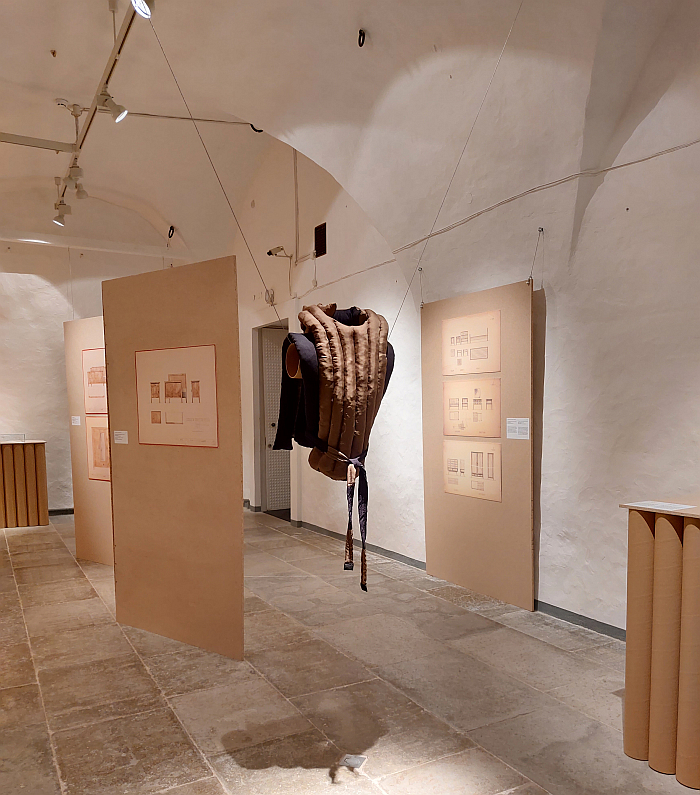
Part of Turvis by Mai Bauvald, and draughts of late 1940s furniture designs, as seen at Uneversum: Rhythms and Spaces, Estonian Museum of Applied Art and Design, Tallinn
For all that Uneversum’s focus is sleep, and for all that viewing it is a very relaxing experience, not least on account of the open, untroubled pace of the exhibition design, the tranquil ease of the whitewashed vaulted space in which you find yourself, Norman Orro’s slightly hypnotic sound installation Organic Noise Machine playing away in the background, and the rhythmically changing hues of Helga Schmid’s aforementioned Circadian Dreams, Uneversum is not a presentation that induces you to sleep, for that there is far too much cerebral stimulation. Far to much engagement offered. Nor indeed should it induce sleep, for it is but one part of a wider exploration of sleep, but one part of a couplet of exhibitions, technically a triplet: Tower of Dreams at the Estonian Theatre and Music Museum has however now closed, was closed before we could make it to Tallinn, sadly, but Universe of Sleep is ongoing across the road from the ETDM in the Estonian Health Museum.7
A partner exhibition in the Estonian Health Museum that is primarily concerned with sleep as a biological process and a physiological process, that helps elucidate for all that sleep is biologically and physiologically simple to explain, as a process it is biologically and physiologically as complex as it is conceptually complex; and an exhibtion which, if one so will, and which given its location shouldn’t surprise anyone, explores sleep’s relationship with health, the health benefits of sleep and the means of achieving a truly healthy sleep.
A showcase that includes brief discussions on, for example, the fact that we all have different demands, and different cycles, that we all have our own internal clocks, that a Richard Buckminster Fuller with his four half hour naps is no more wrong or right than a Dakota Johnson with her 10-14 hours a night, we’re all different; on the role of sleep in context of the body replenishing and repairing the damage of the day, of, if one so will, a re-setting, re-booting through sleep, and thus underscoring why sleep is essential; or the question if it is better to sleep on your own or to share your bed, the curators making cases for both without committing, rather leaving it up to each individual couple to decide what is best for them.
And also presents tips for improving the health promoting effects of sleep, of getting a good healthy sleep, including, and amongst others, reading a book or solving sudokus before going to bed, not drinking alcohol before going to bed , or the benefits of partaking in physical activity three hours before bedtime, but importantly no intense physical activity an hour before bedtime…….
……. ……. …….
……..we’ll done, you’re obviously taking things more seriously now, we’re impressed…….
…….Or turning your phone off an hour before bed and not looking at it again until you’re through with sleep, for not only is the stimulation of knowing how many steps you took that day and buying second hand jumpers bad for sleep, but the light from your phone physically hinders the production of melatonin, and thus that hormone that induces sleep; our linear ‘on’ phones violently, irrevocably, disrupting the quiet flow of melatonin, of ‘off’. Thus confirming an actual biological, medical, reason for not taking your phone to bed with you. Answering the question if it’s better to sleep on your own or to share your bed (with your phone) unequivocally in favour of the former. And a long list of factors which hinder a good healthy sleep which tends to imply that while we can prepare our nests as carefully and diligently as we want, we can negate all that work with the greatest of ease. And invariably do.
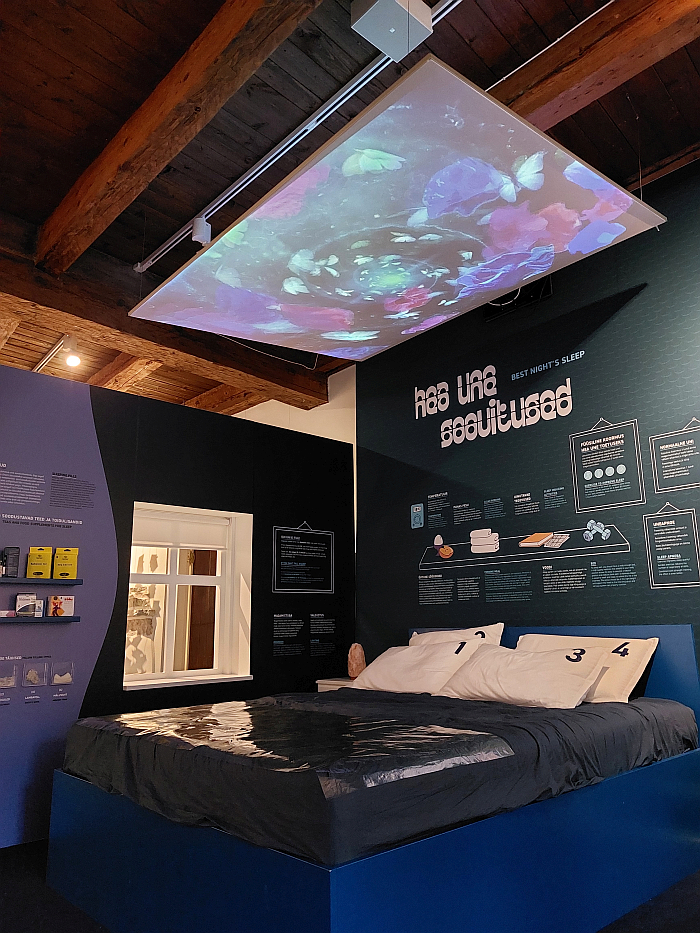
Advice for achieving good healthy sleep to ensure good, healthy dreams, as seen at Universe of Sleep, Estonian Health Museum, Tallinn
Alongside the numerous tips on achieving a good healthy sleep stands a brief discussion on sleeping pills and teas and supplements to help induce sleep when it won’t come naturally; and while we’re absolutely certain that our forbearers would have been very familiar with the sleep inducing qualities of many herbs, and similarly don’t doubt that in the distant past ill health and anguish kept people awake necessitating the use of such herbs, contemporary global levels of consumption of sleeping drugs, both natural and synthetic, prescribed and unprescribed, the numbers of us who regularly, necessarily, consume sleeping pills and potions, is inarguably a consequence of contemporary society’s aggressive, hostile, relationships with sleep, our dissociation of sleep from our natural rhythms, our sleeping with phones, et al. And surely a cause for more reflection than it popularly is. Similarly the ongoing research and development into new synthetic drugs to induce sleep forces one to pose the question, why?
Thoughts on stimulants to send us to sleep that sit joyously juxtaposed with coffee, that stimulant to keep us awake, that stimulant without which the rise of industrialisation in the course 19th century arguably simply wouldn’t have been possible, and certainly the rise of digitalisation in the late 20th century wouldn’t have been possible. And coffee which one meets, engages with, but can’t physically consume, back across the road in the ETDM in context of Douwe en Egbert by Dutch designer, and early inhabitant of the Droog universe, Eibert Draisma, a project from 1996 realised in context of Draisma’s wider development of talking coffee-makers, and in which Douwe prepares coffee, let’s say in the kitchen, while Egbert, standing, let’ say on your office desk, but wirelessly connected with Douwe in the kitchen, informs you when the coffee is ready. A wonderful example of smart networked technology in an age before smart networked technology, a wonderful example of the Internet of Things in an age before the Internet of Things; and an equally wonderful reminder of the speed with which smart networked technology, and the Internet of Things, have taken over, has allowed us to not only work from bed but to control our coffee machines, and all other domestic tools, from bed and to (before all to long) control the robots that bring us our coffee in bed so that we can concentrate on work. And thus a wonderful reminder that with all the high-speed travelling we’ve been doing since the early 1990s, has anyone been checking the map?
And an Internet of Things before an age of Internet of Things that reminds that one of the earliest recorded examples of the Internet of Things was the coke vending machine at Carnegie Mellon University, Pittsburgh, Pennsylvania, which in the early 1980s computer science researchers wired up so that they knew how much cold coke was available and so saving a trip to an empty vending machine. Or worse a trip to a vending machine only full of recently placed warm bottles. An example that is not only as playfully pointless yet playfully practical as Douwe en Egbert, but Coke also famously contains caffeine. Thus underscoring the central role caffeine has played in society’s move away from sleep. Whereby it would be most interesting to know details of Richard Buckminster Fullers early 1940s coffee habit. We’re thinking high. Very high. And two networked caffeine dispensers that serve as a further reminder of the role of techies in the recent changes to human society, the role of techies in the development of our societies’ contemporary malaises, and thus caffeine fixated projects which imply that expecting techies to get us out our predicaments might be just a little bit naive. A little bit delusional. Maybe we should look elsewhere. Maybe we should ask someone else to frame the questions.
¿Ourselves?
¿Us all?
¿Individually and collectively?
¿Really?
¿Not relying on global tech concerns to solve the problems of society?
¿Could that work?
???
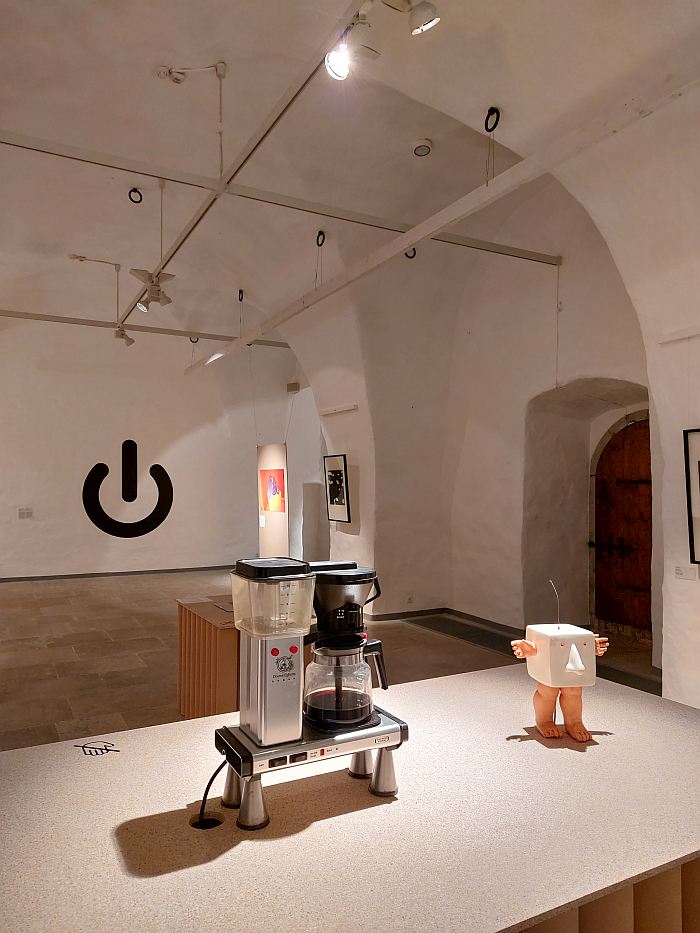
Douwe en Egbert by Eibert Draisma (Douwe left, Egbert right) and the ‘Power’ logo, as seen at Uneversum: Rhythms and Spaces, Estonian Museum of Applied Art and Design, Tallinn
An easily accessible, informative and entertaining exhibition Uneversum unfolds its narrative via a very satisfying, well considered, mix of architecture and design projects, a mix that enables the four chapters despite their very different foci to neatly intertwine and interact to create a coherent whole; a mix of projects both tangible, physical and more speculative, experimental, which helps reinforce that architecture and design are ways of thinking, positions, and not something you can post on Instagram or organise a competitive TV show around; a mix of projects from across the past 120+ years that allow one to better appreciate how architecture and design have simultaneously responded to and contributed to, helped drive, social and cultural changes, and why the balance between response and drive is important; a mix that admonishes that architecture and design are only ‘epochs’ in academic and coffee table book contexts, and in commerce, as cultural practices they are always in the now, always looking forward, but always in close dialogue with the past; a mix that allows one to better appreciate that while a Tõnu Riit is unquestionably correct in his assertion that “disaini üheks põhilisemaks ülesandeks on inimese ja keskkonna vaheliste suhete reguleerimine”8, ‘one of the most basic tasks of design is to regulate the relationship between people and the environment’, that needn’t necessarily, automatically, be a positive regulation, a Victor Papanek’s contention that “there are professions more harmful than industrial design, but only a very few of them”9, remains valid, as does his contention that Advertising Design is one of those more harmful professions, caution is always to be recommended.
A mix that makes clear that for all that sleep is without question a biological process and a physiological process it is also defined by political, economic, social, technical, physical and emotional aspects, aspects which in our complex contemporary societies influence and control sleep much more than the biological and physiological that influence and control sleep in other animals. And once influenced and controlled sleep in us. Animals as we are.
Political, economic, social, technical, physical and emotional aspects that impinge on, disrupt, the biological and physiological process every bit as much as ‘on’ disrupts the natural cycle of ‘off’ in the International Electrotechnical Commission’s standard ‘Power’ symbol, and therefore makes Uneversum an admonishment to think more seriously about sleep……. and, no we don’t mean to analyse in more detail your sleep App, to analyse more deeply your sleep phases and your REM cycles as depicted by your sleep App…….
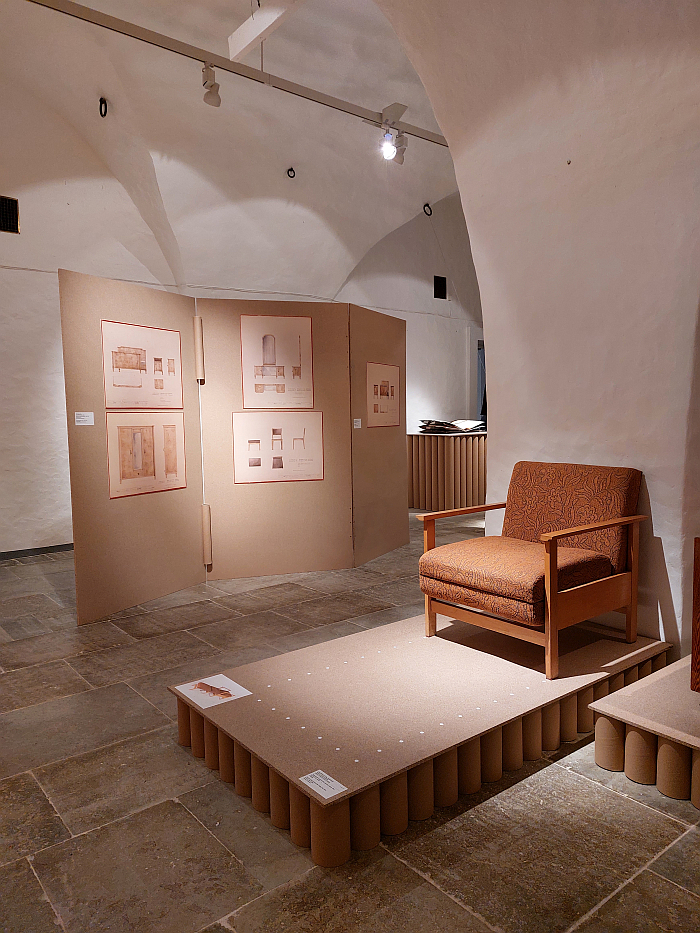
The M-259 armchair-bed by Valentin Kuusk for Narva Mööblivabrik, and a variety of late 1940s furniture designs, as seen at Uneversum: Rhythms and Spaces, Estonian Museum of Applied Art and Design, Tallinn
…….although that said, that is actually quite a good place to start.
To start with a questioning of why you have such an App, the role and function of that App in your life, why there is such a universal demand for such an App. Why is there such a universal demand for sleeping pills and potions? Why is there such a universal demand for caffeine and energy drinks? If your sleep App allowed Californians access to your dreams would you let them? And would you let them if they paid an Influencer large sums to tell you that it would help optimise your sleep? Help optimise your sleep to enable you to work more efficiently and optimise your life?
Do we need to optimise our sleep or to regain control of our sleep, regain control of our sleep spaces and sleep rhythms? The Chinstrap penguin doesn’t have 10,000 micro-naps a day by way of optimising its sleep rather by way of stopping other penguins stealing its eggs, or to stop scientists sneaking up and attaching brain monitors to them, sleep in animals isn’t optimised, its appropriate. But we optimise, and that invariably through analysis, through measuring and timing and charting, through inventing parameters and forms deemed best, desirable, a habit bequeathed us by inter-War Functionalist Modernists like Margarete Schütte-Lihotzky with their Taylorist understandings of the world, and extremely rational but thoroughly impractical words for houses, an understanding, a legacy, the likes of a Niina Eigi tried to wean us of, tried to explain that was but one possible path, that there were others. But a Functionalist Modernist path of optimisation through measuring and charting we stick to, arguably because its the easiest path. And because the arguments of a Niina Eigi are rarely quadratic, rarely comply with our culturally conditioned definitions of ‘rational’. And now we have Californians who can develop Apps to confirm that the Taylorist path is correct. And Influencers who reinforce the Californians’ message for banal financial gain.
And, yes, for all that a Richard Buckminster Fuller can be accused of optimising his sleep, he was much more seeking to adapt his sleep pattern to that which his body demanded, seeking appropriate sleep, seeking to regain control of his sleep rhythm, sleeping when he felt was most meaningful for him and not when convention demanded he sleep. A relatively new convention as one learns in the Estonian Health Museum: apparently in the Middle Ages two four hour sleeps a day was the norm before industrialisation forced us to squeeze our sleep into one block; an, if one so will, intermediate stage between rising and sleeping with the sun and adapting to the increasing complexities of economic society. And while a Dakota Johnson may or may not sleep 14 hours a day, and we genuinely don’t care if she does or doesn’t, her statement that “sleep is my number one priority in life”10 is well worth reflecting on: how many of us can say that “sleep is my number one priority in life”? How many of us should? How many of us have even considered if we could, should say that? Questions which allow one to approach an appreciation that the seriousness with which we take sleep is not reflected in how long we sleep, nor how well we can adjust our sleep to fit some idealised chart on our App, nor how we furnish our nests, but the place it has in our lives, the priority we give our spaces of sleep, the priority we give our rhythms of sleep, the priority we give our relationship with sleep. We’re all different, all have different needs and cycles yet society offers a one sizes fits all approach to sleep, and that not least because of the demands of the economy. But is that the only option? Even given the complexity of contemporary society? The society of yore ain’t coming back, can’t come back, but is the status quo as it has developed over recent centuries the only option for our complex contemporary society? Could we do things differently? Should we do things differently? What if sleep wasn’t a commodity but a priority?
Uneversum helps one better appreciate that how we approach and seek to resolve the questions of our relationships with sleep, our spaces for sleep and our rhythms of sleep will have an important role in defining the further path of European society, and does so in a manner that helps elucidate, and admonish, that for all that sleep is a biological process and a physiological process, going forward the questions we need to pose aren’t ones of biology or physiology, and are anything but straightforward……
Uneversum: Rhythms and Spaces is scheduled to run at the Estonian Museum of Applied Art and Design, Lai 17, 10133 Tallinn until Sunday April 7th.
Full details can be found at www.etdm.ee
Universe of Sleep is scheduled to run the Estonian Health Museum, Lai 30, 10133 Tallinn until Sunday November 17th.
Full details can be found at https://tervisemuuseum.ee
Tower of Dreams ran at the Estonian Theatre and Music Museum between between May 24th 2023 and January 7th 2024.
Details can be found at www.ajaloomuuseum.ee
In addition there is an online virtual exhibition Dream Stories
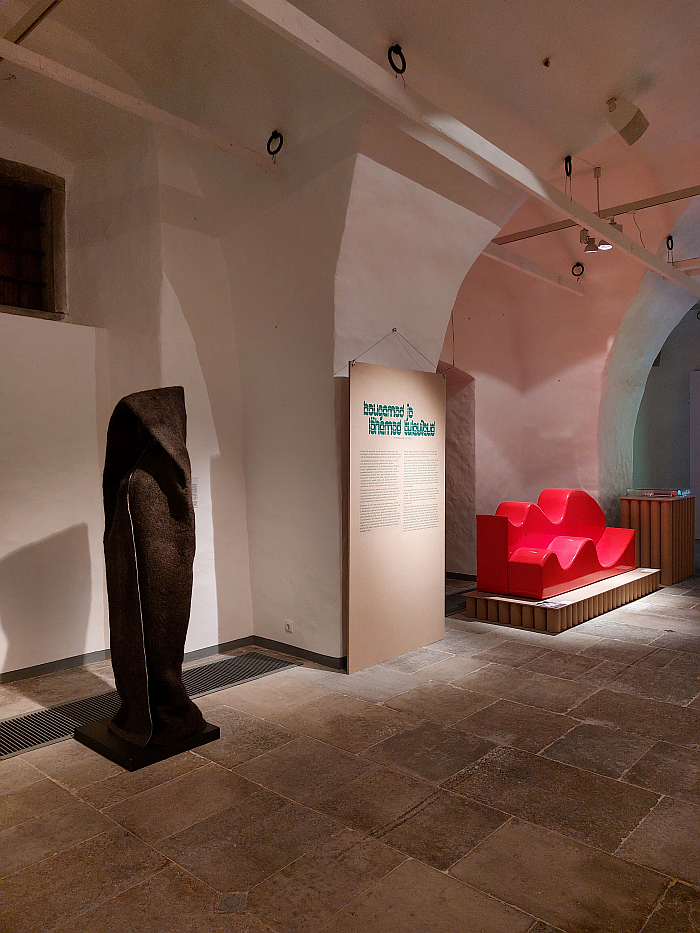
Sartorial Space by b210 arhitektid, Anette Niine & Liisi Tamm (l) and Poltronova by Archizoom (r), as seen at Uneversum: Rhythms and Spaces, Estonian Museum of Applied Art and Design, Tallinn
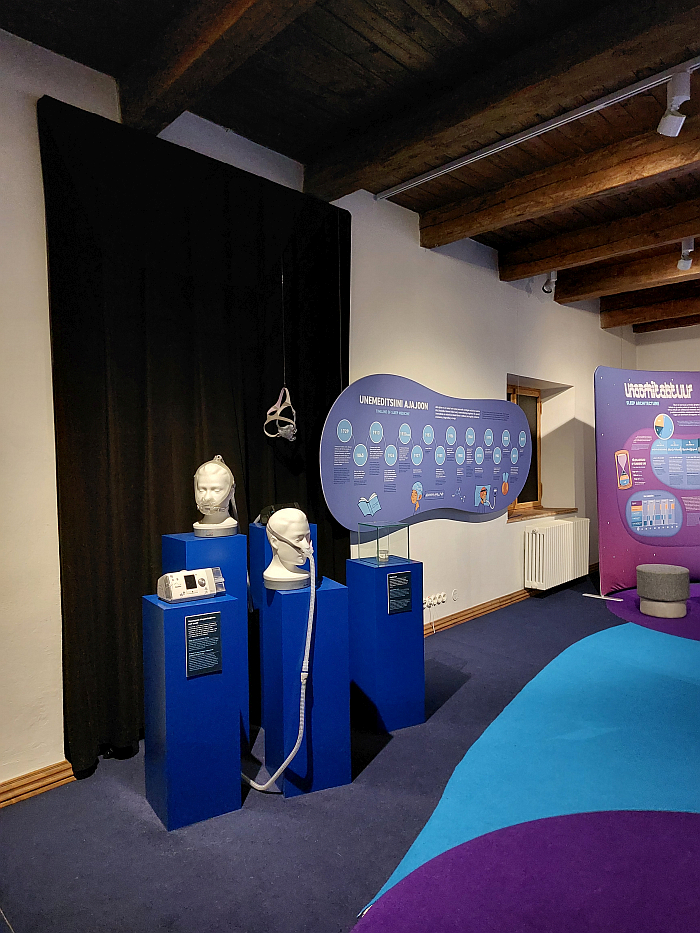
Technical solutions for sleep related medical conditions, as seen at Universe of Sleep, Estonian Health Museum, Tallinn
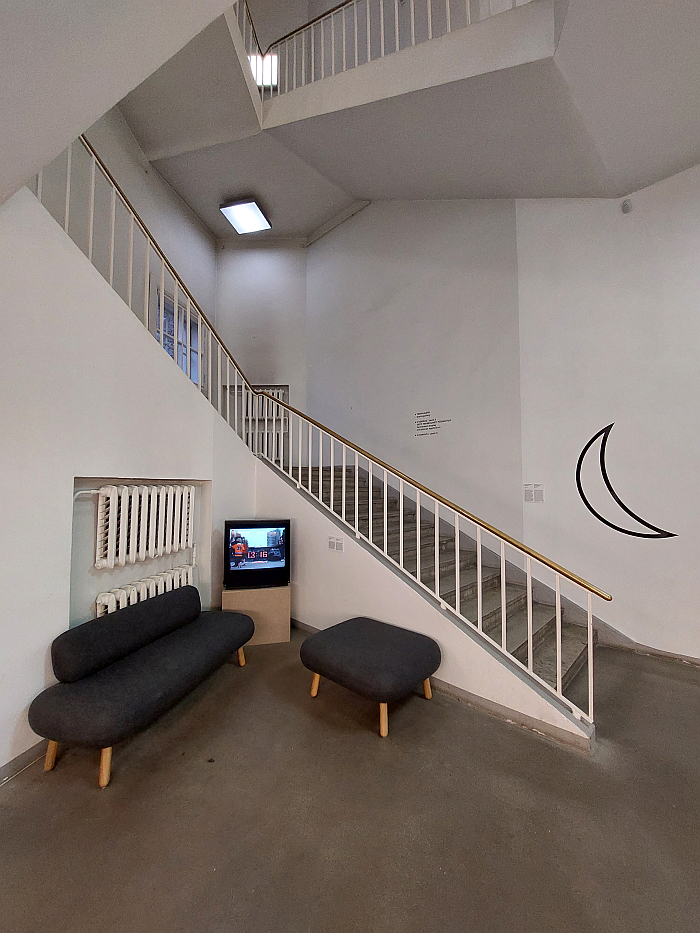
The intervention Central Station Clock by Koit Randmäe and Margo Niit, as seen at Uneversum: Rhythms and Spaces, Estonian Museum of Applied Art and Design, Tallinn
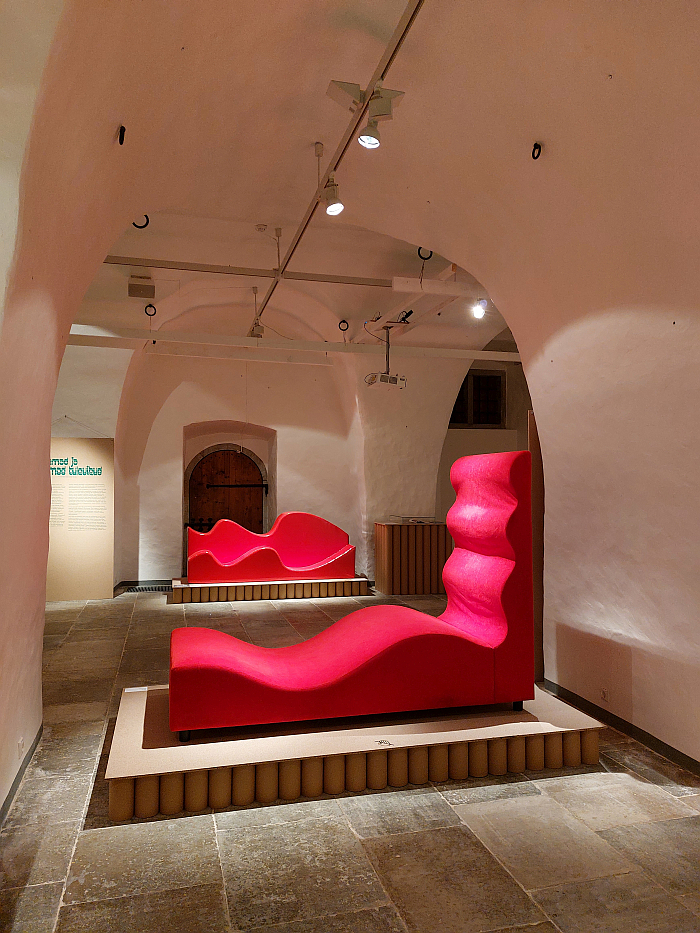
Punane by Maile Grünberg (front) in dialogue with Poltronova by Archizoom (rear), as seen at Uneversum: Rhythms and Spaces, Estonian Museum of Applied Art and Design, Tallinn
1. Tõnu Riit, Aeg ja Kellad, Kunst ja Kodu, Nr. 1, 1975, pages 3-7
2. Richard Buckminster Fuller quoted in Dymaxion Sleep, Time, Vol. XLII, Nr. 15,October 11th 1943 page 63-64
3. Paul-Antoine Libourel et al, Nesting chinstrap penguins accrue large quantities of sleep through seconds-long microsleeps, Science, Vol. 382, Issue 6674, 30th November 2023, pages 1026-1031
4. Sue Shellenbarger, More Work Goes ‘Undercover’, Wall Street Journal, Wednesday 14th November 2012, D 1 & D5
5. George Wilson’s chair, admittedly, wasn’t specifically designed for smaller apartments and, arguably, fits more in the (hi)story of the mechanical recliner as wonderfully exemplified by the work of an Anton Lorenz, however it is we’d argue also a valid and informative example of an armchair-bed. For images of Wilson’s chair see Sigfried Giedion, Mechanization takes Command. A contribution to anonymous history, University of Minnesota Press, 2013 page 409ff
6. Hans Hollein, Neue Medien der Architektur, Fragmentarische Anmerkungen zu neuen Entwicklungen und Möglichkeiten, 1967 (available via https://www.hollein.com/ger/Schriften/Texte/Neue-Medien-Architektur accessed 05.02.2024)
7. Technically the whole exhibition series is titled Uneversum, Uneversum essentially translating as Universe of Sleep i.e. the title of the Health Museum exhibition; however, for reasons of readability we’re pretending here that that Uneversum is only the title of the ETDM exhibition, apologies…….
8. Tõnu Riit, Aeg ja Kellad, Kunst ja Kodu, Nr. 1, 1975, pages 3-7
9. Victor Papanek, Design for the Real World. Human ecology and social change, Thames & Hudson, 1985, Preface
10. Lane Florsheim, Dakota Johnson Likes to Sleep for 14 Hours a Night, Wall Street Journal, December 11th 2023
Tagged with: bed, bedroom, estonia, Estonian Health Museum, Estonian Museum of Applied Art and Design, ETDM, Power, Sleep, Tallinn, Uneversum, Uneversum: Rhythms and Spaces, Universe of Sleep
